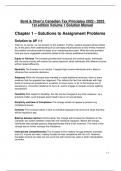Exam (elaborations)
Solution Manual for Byrd & Chen's Canadian Tax Principles st edition Volume 1 / All Chapters 1 - 10 / Full Complete 2023
- Course
- Institution
- Book
Solution Manual for Byrd & Chen's Canadian Tax Principles st edition Volume 1 / All Chapters 1 - 10 / Full Complete 2023
[Show more]




